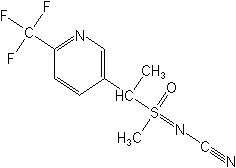Note from the Fluoride Action Network (EC)
Mentioned in this article is Sulfoxaflor, a fluorinated insecticide that is highly toxic to bees. U.S. EPA gave Dow AgroSciences unconditional approval for its use in 2013. In 2015 EPA revoked all it uses after it was remanded to do so by the 9th Circuit court. However, EPA found a way to continue its use by allowing its application on crops after they flower. Its CAS name is: N-[methyloxido[1-[6-(trifluoromethyl)-3-pyridinyl]ethyl]-?4-sulfanylidene]cyanamide and its molecular structure is

____________________________________________________
Excerpts:
- With Brazil’s Bolsonaro administration in power for just 100 days, it has already approved 152 new pesticides for use, a record in such a short period of time, while another 1,300 pesticide requests for authorization from transnational companies await action. Most requests are from U.S., German and Chinese companies.
- Brazil is already the world’s largest user of pesticides and has an acknowledged pesticide poisoning problem, with 100,000 cases reported annually, with likely many more not reported. Agriculture Minister Tereza Cristina denies that pesticide fast tracking will cause any serious environmental or health problems.
- Newly authorized this year are the fungicide mancozeb (mostly banned in Canada), pesticide sulfoxaflor (associated with bee colony collapse disorder), and insecticide chlorpyrifos (banned in the U.S. in 2018 and associated with development disabilities in children).
- The control of both the executive and legislative branches of the Brazilian federal government by the bancada rualista agribusiness lobby means that it is very likely that bill PL 6299/2002 — called “the poison package” by critics — will be voted up this year. The legislation would greatly deregulate the approval process for pesticides.
With the ruralist lobby now in control of key sectors of the federal government, Brazil is rapidly approving new pesticides for use, some of which critics say are either unnecessary or excessively toxic. During the first 100 days of the Jair Bolsonaro administration, the Agriculture Ministry authorized the registration of 152 pesticides, putting Brazil on course to authorize more pesticides this year than in any previous year. Brazil is already the world’s largest user of pesticides.
The number of pesticides authorized each year has risen rapidly, from 139 in 2015 under the Dilma Rousseff administration, to 450 in 2018 under the Michel Temer government (see graph). An even higher number is expected to enter the Brazilian market this year, as the Agriculture Ministry considers registration of roughly another 1,300 pesticides. Most of these requests are coming from foreign multinational companies, mainly based in the United States, Germany and China, which is increasingly becoming an important supplier…
Controversial pesticides approved for first-time Brazilian use
Several of the pesticides authorized this year will be entirely new to Brazil. Some have already been classified by Brazil’s National Health Surveillance Agency (ANVISA) as “extremely toxic.” These include: mancozeb, a broad-spectrum fungicide used in agriculture and horticulture; the fungicide fluazinam; and the insecticide chlorpyrifos. In 2018 the Pest Management Regulatory Agency (PMRA) banned the use of mancozeb in Canada, except for foliar use on potatoes, due to “unacceptable risks to human health.” The US Environmental Protection Agency (EPA) banned the use of chlorpyrifos in 2018 after its use had been associated with development disabilities in children.
One particularly controversial newly approved chemical is sulfoxaflor. This pesticide was one of several believed to have caused an outbreak in Brazil of colony collapse disorder — the catastrophic sudden disappearance of worker bees from a bee colony, leading to the death of hives. According to a survey carried out by Agência Pública and Repórter Brasil, half a billion bees were found dead in four Brazilian states in the first quarter of 2019 — a staggeringly large die off posing a threat to the pollination of fruits and vegetables and to native vegetation.
But at a 9 April press conference, Agriculture Minister Cristina seemed unaware that Brazil has already authorized sulfoxaflor. She said then: “The problem with the bees is that a product called sulfoxaflor was used. This [toxin] is not registered in Brazil.… It probably entered Brazil illegally and is being used incorrectly and thus caused the death of the bees.” In fact, sulfoxaflor was authorized at the end of last year by the Temer administration, though the official decree was only issued in January of this year under the Bolsonaro government.
Sulfoxaflor is classified by Brazil’s ANVISA as “averagely toxic,” but this evaluation is challenged abroad. Dow Chemical initially developed sulfoxaflor as a safer alternative to neonicotinoids, known to be harmful to bees. It was initially approved by the US EPA in 2013, a decision reversed in 2015 when studies found that sulfoxaflor was also dangerous to bees. Today sulfoxaflor can still be used in the U.S., but only in restricted circumstances…
*Read this excellent article online at https://news.mongabay.com/2019/05/bolsonaro-administration-authorizes-150-pesticides-in-first-100-days/
